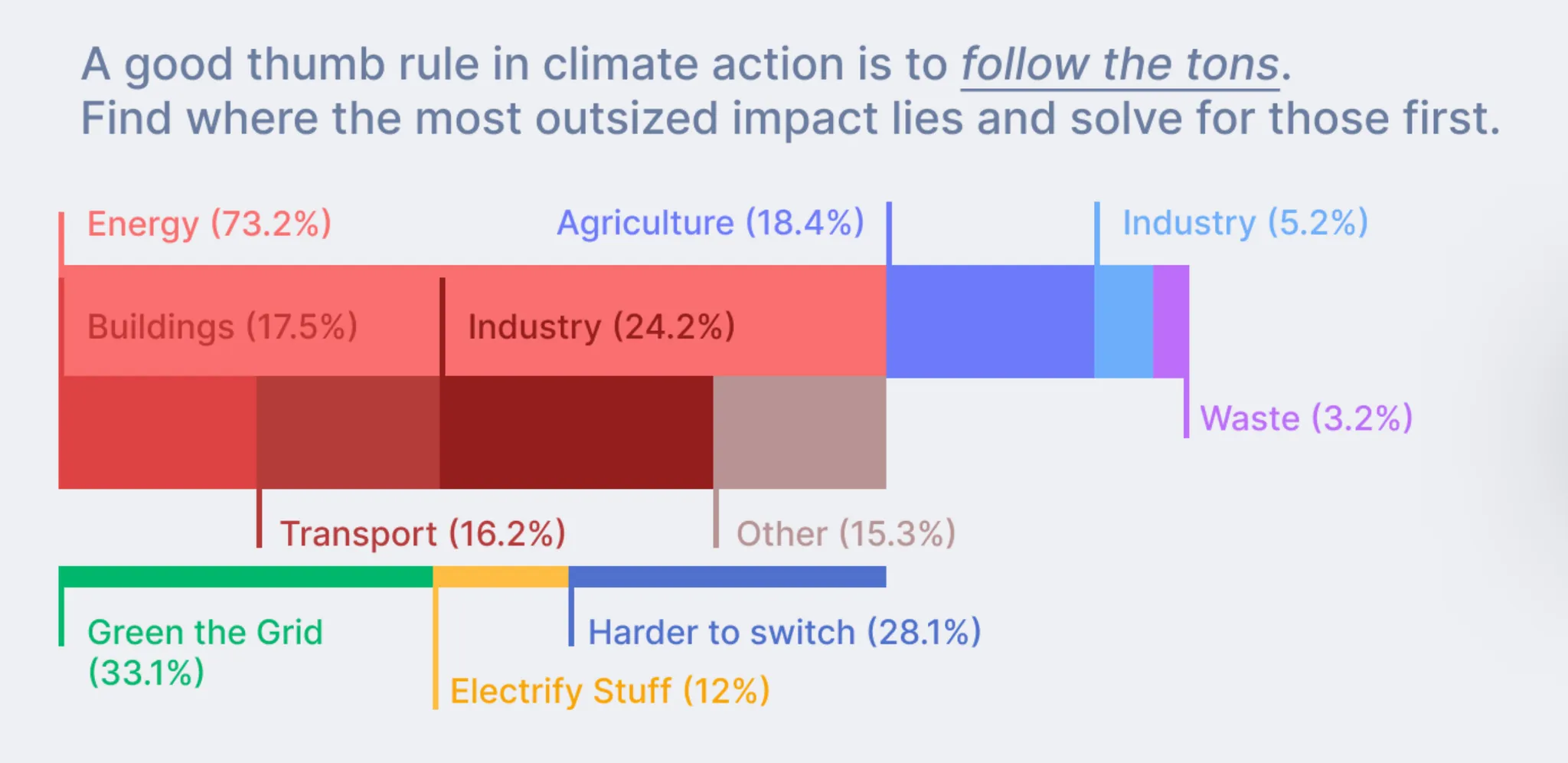The climate crisis in India is no longer a distant warning, it’s unfolding around us. From extreme weather patterns to rising carbon emissions, we’re witnessing irreversible damage at an alarming pace. This crisis isn’t just about warming temperatures, it’s a systemic failure that demands urgent, cross-disciplinary solutions rooted in clean energy, transparency, and collective action.
Solving for climate change has no silver bullet solution; it’s highly unlikely that we can invent our way out of it. For effective climate crisis action, it needs to cross-cut technology with policy, politics, finance, as well as the larger cultural movement. Technology here becomes an enabler, a flywheel of sorts that brings momentum to collective action and drives integration of sustainable approaches into our economic system.

Rethinking Development in the Age of Climate Emergency
Our relentless pursuit of growth has placed us on the edge of environmental disaster. The climate emergency we face today goes far beyond temperature spikes. It’s triggering a domino effect across ecosystems, agriculture, infrastructure, and public health.
To combat this, we need a framework for sustainable development, one that prioritizes decarbonization, ecosystem accountability, and non-extractive economic growth. Technology alone won’t solve this. It needs to work alongside strong policies, financial support, and cultural transformation.
Effective Ways to Slow Down Climate Change Through Sustainable Choices.
- Rapid temperature increases lead to irreversible changes to our climate.
- Ways to lower the impact/ reduce the velocity of climate change:
- Use clean & renewable power, individually by installing solar panels or by subscribing to digital solar.
- Seek out less carbon-intensive alternatives to materials and food products.
- Switch to electric mobility and logistics. Choose public modes of transportation.
How Renewable Energy Can Help Tackle the Climate Crisis in India
Powering India with Clean Energy Sources
The way we generate power plays a huge role in climate change. Shifting to renewable energy is the first step in reducing our carbon footprint.
Grid-Level Renewable Energy
A macro-level clean energy grid allows homes and businesses to use renewable power directly while feeding excess energy back to the system. This reduces reliance on non-renewables and cuts down storage costs.
Localized Microgrids
Microgrids are small, independent energy systems that serve as backups or primary sources in remote or disaster-prone areas. They provide energy security and complement the main power grid.
Smarter Energy Storage Systems
To counteract the intermittent nature of solar and wind, we need smart storage:
- Home Batteries store solar power for use at night or during outages.
- Dams-as-Storage use excess energy to pump water, later generating electricity when released.
- Vehicle to Grid (V2G) tech enables EVs to act as mobile energy storage.
Virtual Grids connect every available renewable source and battery into one intelligent system—sharing power between homes, vehicles, and factories efficiently.
High-Impact Systems Driving Carbon Emissions and Environmental Degradation.
A closer look at our systems and processes, we find certain categories that are more extractive and carbon-heavy than others, such as;
- The way we power stuff, from entire cities to our phones, and how these are powered.
- The way we move stuff, the logistics of people, goods, and resources.
- The way we make and grow stuff, from how we make food to how we make our buildings.
Tools to Tackle the Climatic Crisis in India: Power, Mobility, and Sustainable Innovation.
In this section, we explore the powerful tools we already have to address the climatic crisis in India by transforming how we power, build, and move.
Powering the World Better: Clean Energy Solutions
-
Going Macro: Clean Power for the Entire Grid
A grid-connected system allows you to power your home or store with renewable energy when the sun is shining, the water is running, or the wind is blowing (daily and seasonally). Any excess energy you generate is fed back into the grid. When renewable resources are unavailable, electricity from the grid meets your needs, saving you the cost of energy storage devices such as batteries.
-
Going Local: The Rise of Microgrids
Microgrids are a localized collection of power generation and storage systems that can operate independently or in tandem with the traditional grid. Microgrids are used as backup while the main grid is down or in places where grid power is not available, as well as serve as support to the grid for faster response and recovery.
Storing Clean Power: From Homes to Highways
Power from renewables such as wind and solar can be erratic and intermittent. Therefore, we need better ways to store this power when the sun is shining and the wind is blowing, and to make that stored power available to use when it’s night or if the wind stops.
1. Home Batteries:
These are integrated battery systems installed within your home that store solar energy from your panels, delivering the power even at night or if the grid goes down.
2. Dams as Energy Storage:
This is pretty ingenious; when there is surplus power available, that extra power is used to pump water back into hydropower dams, and when needed, these dams release water to generate power, functioning as a massive battery.
3. Vehicle-to-Grid (V2G) Technology:
Electric vehicles are essentially batteries on wheels. And as more EVs roll out, we essentially have large storage systems available. V2G technology allows energy to be pushed back to the power grid from an electric car’s battery. So now, these cars can potentially be charged and discharged as per demand, cost of power and requirement.
4. Virtual Grids:
Virtual Grid takes the ideas discussed above to the next level; Instead of the typical way where the grid connects between one large power station to many homes, Virtual Grid connects all the renewables to all the storage available to all the places that needs power, making solar on your home and power stored in your neighbour’s vehicle to the factory down the lane, all part of the grid. Better yet, you get paid for the power from your solar and for using your batteries to store it.
Making Our Stuff Better: Sustainable Production and Agriculture
-
Smarter Farming with Precision Agriculture
This is a farm management method that employs information technology to ensure that crops and soil receive precisely what they require for optimal health and productivity. Precision Agriculture aims to be sustainable while also lowering costs and reducing the chances of the climate crisis in India.
-
Moving Away from Animal Agriculture
Growing animals for meat and dairy is not only morally unethical to fellow living beings, but also has a massive impact on the climate crisis, as most land use and food production is done to support livestock as well as they also emit a vast amount of methane.
Plant-Based Meats and Milk:
Resemble animal meat and dairy but are made from plant cultures. Newer products have been successful in mimicking its taste, texture, smell, and appearance.
-
GMOs to Reduce Fertilizer Pollution
There are very high chances of loss of crops like corn, cocoa, and coffee due to extreme climatic conditions such as drought, floods, and excessive pests. Meanwhile, modified crops could use less polluting fertilisers and help crops withstand these disruptions by providing pest-resistant, drought-resistant, or saltwater-resistant genes that can resist saltwater intrusion from rising sea levels.
Greener Construction: Rethinking Cement and Steel
Cement and steel production not only takes a lot of power, but also needs carbon for its process, making decarbonisation tricky. Some ways of making these materials are to capture the carbon as soon as they are made or to inject the carbon back into the product, making them ‘carbon sinks’. Some interesting ideas are panning out for the first part; capturing carbon, where applications like Direct Air Capture of carbon are proving to be useful.
Moving Better: Low-Carbon Mobility Solutions to Tackle Climate Crisis in India
-
Individual Transportation: Electrification is Key
Electrification of the mobility sector can result in increased energy efficiency and lower local pollution. In India, while there is a high level of participation from both 2 and 4-wheeler segments, surprisingly, the EV revolution is led by three-wheelers (rickshaws). In May, the number of new electric three-wheelers (e3w) sold in the country increased significantly, rising from 50% in each of the three months until April 2022 to 56% overall.
-
Public Transport Goes Electric
As cities strive to reduce tailpipe emissions, the trend toward electrifying city-wide transportation is gaining momentum. Electric buses and trains are being introduced in almost all the big cities around the world. Beyond benefiting climate action, electric mobility can produce more power than their diesel counterparts and even more short-term surge power for fast acceleration, ideal for city use. Cities also benefit from reduced noise and pollution.
-
Battery Swapping for EVs
To address the long charging times, which hinder EV adoption, some vehicle manufacturers are now opting for swappable batteries. In this case, when the vehicle is running low on power, much like how gas cars head to a petrol station, EVs go to a battery station to swap their old batteries for new ones, reducing the time to get going by a considerable margin.
Greener Alternatives in Food and Construction
Transforming Agriculture to Fight the Climate Crisis in India
Agriculture is a major contributor to greenhouse gas emissions, but it doesn’t have to be.
- Precision Agriculture uses tech to optimize crop health and yield while cutting waste.
- Plant-Based Alternatives help reduce the environmental toll of animal agriculture.
- Genetically Modified Crops (GMOs) can adapt to extreme conditions while reducing fertiliser usage and emissions.
Sustainable Construction Materials
Materials like steel and cement are notoriously carbon-heavy. But solutions are emerging:
- Carbon Capture Technologies such as Direct Air Capture can trap emissions.
- Carbon-Injection Techniques aim to make materials act as carbon sinks rather than sources.
Decarbonising Mobility and Logistics
Electric Mobility for Individuals
India’s EV revolution is being led by e-rickshaws and is fast gaining pace in 2- and 4-wheeler markets. Electrification reduces energy use and pollution, especially in cities.
Public Transport Goes Electric
Cities across India are adopting electric buses and metros, reducing emissions and enhancing efficiency. These vehicles also generate more surge power, making them perfect for stop-and-go city traffic.
Battery Swapping for Faster Turnaround
To overcome long charging times, battery swapping stations are now being introduced. Much like petrol pumps, they allow instant battery replacement—encouraging wider EV adoption.
Technology must support this transformation by enhancing transparency—whether it’s tracking product impact or holding policymakers accountable.
Conclusion
While the climate crisis in India is daunting, it’s not insurmountable. We must lean into the solutions already available, from clean energy to community-driven policy changes. But most importantly, we must come together—because fighting climate change isn’t just a technological or governmental task—it’s a cultural one. Let’s choose progress that preserves, empowers, and sustains.






